IMAS: An Overview of New and Amended Standards
By Abigail Hartley [ United Nations Mine Action Service ], Lionel Pechera, and Sasha Logie [ Geneva International Centre for Humanitarian Demining ]
CISR Journal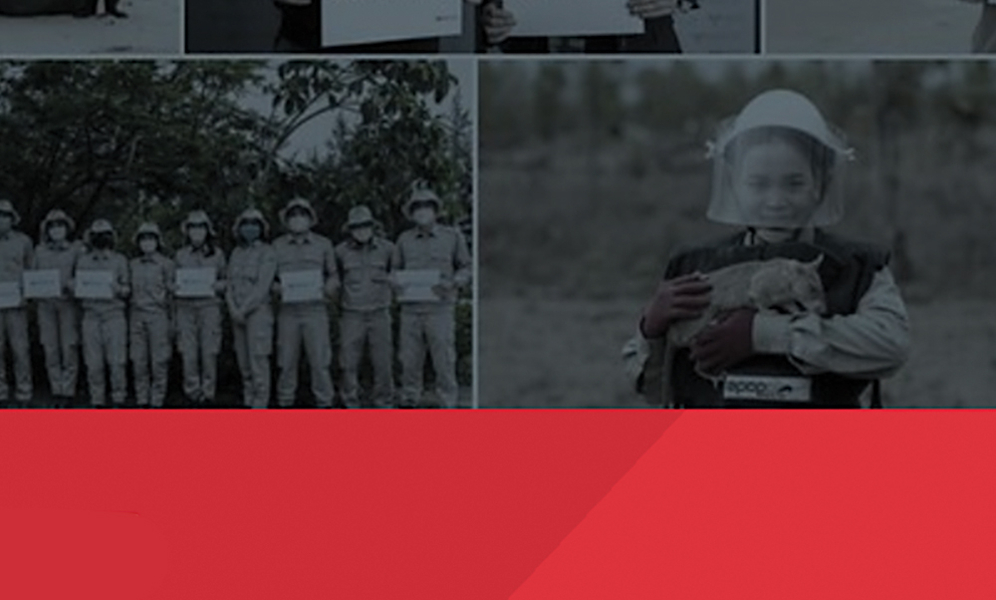
This article is brought to you by the Center for International Stabilization and Recovery (CISR) from issue 27.2 of The Journal of Conventional Weapons Destruction available on the JMU Scholarly Commons and Issuu.com.
New and existing International Mine Action Standards (IMAS) doctrine (including standards, technical notes for mine action, and test and evaluation protocols) are developed and regularly updated to ensure that IMAS remain fit for purpose to support mine action programs in reducing the risk of explosive ordnance (EO) to affected populations. This article provides a summary of the most recent IMAS publications to enable mine action organizations and authorities to stay up to date with the latest IMAS developments.
Introduction
IMAS support mine action programs and organizations by promoting the standardization of safe and effective mine action. The IMAS Review Board (RB), with oversight from the IMAS Steering Group, reviews and revises standards on a regular basis to maintain their continued applicability. This process ensures that IMAS remain consistent with the most recent developments in mine action.
One new IMAS has been released:
- IMAS 07.50, Management of human remains in mine action
The following documents have been revised:
- IMAS 04.10, Glossary of mine action terms, definitions and abbreviations;
- IMAS 05.10, Information management in mine action;
- IMAS 06.10, Management of training;
- IMAS 08.40, Marking explosive ordnance hazards;
- IMAS 10.30, Personal protective equipment; and
- IMAS 13.10, Victim assistance in mine action.
In addition, one new Test and Evaluation Protocol (T&EP) has been released, and one existing Technical Note for Mine Action (TNMA) has been revised:
- T&EP 07.31.02.2022, Competencies required for ADS handlers, team leaders and instructors;
- TNMA 12.10.01, Risk education for improvised explosive devices.
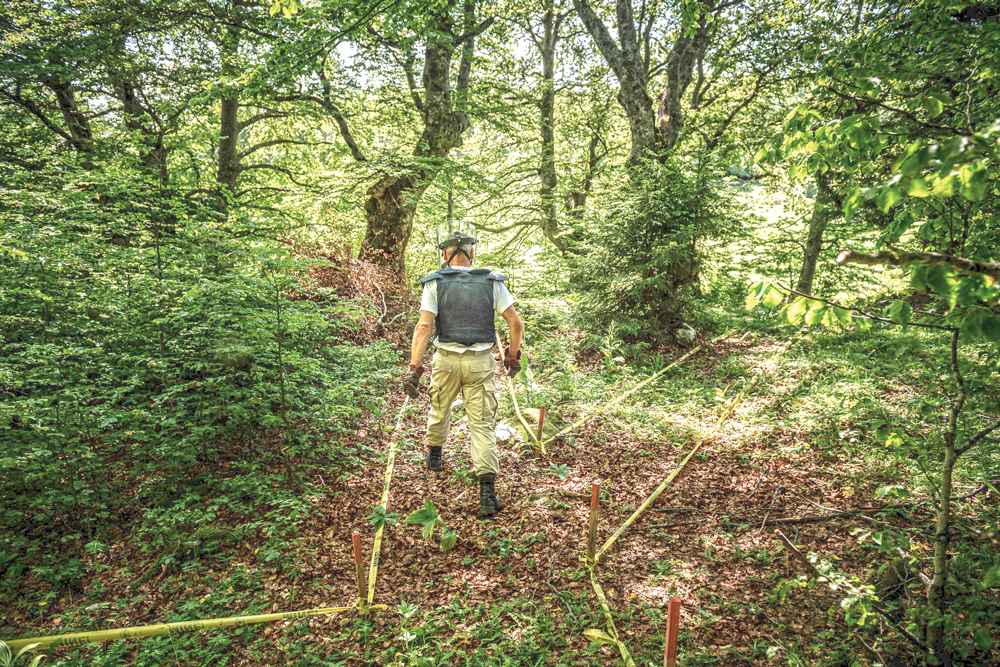
A Norwegian People's Aid clearance site in Bosnia and Herzegovina, 2018. Courtesy of Johannes Müller
The publication of these documents in late 2022 to early 2023 marks the culmination of nearly two years’ work by the IMAS RB and multiple technical working groups composed of subject matter experts from across the mine action sector. The updated and amended doctrine reflects broad consensus between countries affected by EO, donors, the United Nations, mine action operators, and the Geneva International Centre for Humanitarian Demining (GICHD). Gender and diversity perspectives were taken into consideration throughout the process.
This article provides a short overview of each of the IMAS documents noted and highlights the key themes that practitioners should be aware of. All documents are available on the IMAS website.1
New International Mine Action Standards
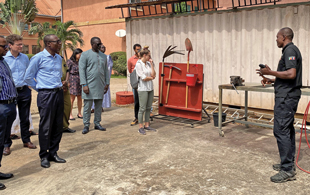
GICHD Francophone Regional Cooperation Program Workshop at CPADD. Courtesy of GICHD.
IMAS 07.50, Management of human remains in mine action
Following requests for better guidance from mine action operators, the new IMAS 07.50 provides national mine action authorities and mine action organizations with guidance for the management of human remains in EO-contaminated contexts. While the standard recognizes that managing human remains is beyond the remit of mine action, it emphasizes that the sector has a responsibility to help ensure that the dignity of the deceased is preserved, and that human remains can be recovered and identified by the relevant authorities and agencies.
The standard provides minimum requirements to situations where human remains may be encountered in two scenarios: Firstly, when human remains are likely to be found, or are found incidentally during mine action operations, and secondly, when mine action support is requested to assist interventions for the recovery of human remains.
IMAS 07.50 stipulates that mine action organizations have the possibility to refuse requests to provide mine action support, based on context and circumstances.
In light of this new chapter, a technical working group formed by the IMAS RB is reviewing the TNMA 10.10/01 Guidelines on the management of human remains located during mine action operations.
Revised IMAS
IMAS 04.10, Glossary of mine action terms: definitions and abbreviations
Terminology is essential to standardization. Using a commonly understood language facilitates mutual understanding and ways of working among mine action stakeholders.
The revision of IMAS 04.10 includes the addition of a new annex which provides guidance for the management of terminology in IMAS to ensure that mine action terms and definitions that are entered, deleted, or amended throughout the IMAS framework are managed in a consistent and standardized manner.
The guidance also provides a useful framework for national authorities in the management of terminology within national mine action standards (NMAS), including where mine action terms are translated from English into other languages.
IMAS 05.10, Information management in mine action
IMAS 05.10 has been amended to include definitions of the beneficiaries of mine action interventions. Much of the content of this amendment derives from the existing guidelines on Standardising Beneficiary Definitions in Humanitarian Mine Action, published by a group of mine action international nongovernmental organizations (INGOs), which are already being applied by many mine action organizations.
Annex B of IMAS 05.10, which addresses minimum data requirements in mine action, has been amended to incorporate the definitions of direct, and in some instances indirect, beneficiaries of:
- explosive ordnance risk education (EORE);
- land release;
- explosive ordnance disposal (EOD) spot task; and
- victim assistance (VA) (consistent with the also amended IMAS 13:10).
IMAS 06.10, Management of training
IMAS 06.10 addresses training provisions which are essential to the safety, effectiveness, and efficiency of mine action.
The revised document focuses on training where the degree of achievement of learning is formally assessed and documented. This focus aims to guarantee the quality and recognition of competencies acquired by the trainees.
The content is structured according to a management cycle comprising six steps and starting with the analysis of training needs. The new edition is aligned with quality and risk management as described in IMAS 07.12 and IMAS 07.14. The combination of requirements for the management of training and competency standards aims to reinforce the safety and efficiency of mine action.
IMAS 08.40, Marking explosive ordnance hazards
IMAS 08.40, formerly known as “marking mine and explosive remnants of war hazards,” has been revised and published in its third version.
In contrast to the previous edition, which was centered on the type of marking or physical barrier (permanent versus temporary), the current edition focuses on marking efficacy. It also recognizes the difficulties associated with marking hazardous sites.
In accordance with relevant IMAS chapters, it strengthens the link between marking, risk management, and quality management. It handles issues such as long-term monitoring to safeguard the efficacy of marking over time.
The strategy for community engagement was also revised. While the previous edition addressed the population's responsibility to preserve existing markings, the revised version emphasizes the importance of liaising with the population at an earlier stage to enable effective marking. In accordance with IMAS 12.10 on EORE, a section on the relationship between EORE, community liaison, and the general population regarding marking has been added.
This third edition specifies further the obligations of national mine action authorities and mine action organizations. The description of tasks aims to ensure the long-term monitoring and maintenance of marking, which has been identified as a problem in multiple countries. The standard also includes guidelines for ensuring contaminated buildings are properly identified.
Finally, this new IMAS 08.40 features modified terminology. The terms "danger sign" and "mine sign" were replaced by "explosive ordnance sign," and the term “explosive ordnance marking” was substituted for the terms “marking,” “marking system,” and “hazard marking system.”
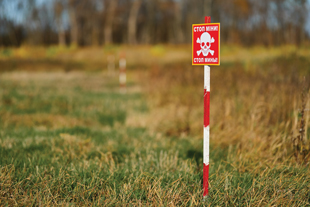
A mine sign in Ukraine captured during a GICHD workshop in 2022. Courtesy of GICHD.
IMAS 10.30, Personal protective equipment
The RB reviewed IMAS 10.30, as it had not been reviewed since 2013. The review led to minor amendments to the existing standard. The new version also removed the requirement for ballistic boots to better align the IMAS with the experience of mine action operators on the ground.
IMAS 13.10, Victim assistance in mine action
Although victim assistance (VA) is the responsibility of the government of an EO-affected state, this standard describes the specific roles and responsibilities of the mine action sector in supporting VA.
The standard describes the roles and responsibilities of national mine action authorities and national mine action centers working in support of relevant government entities charged with coordinating and providing VA to meet the needs and address the rights of victims. It also identifies the roles of mine action operators, as well as the United Nations and survivor organizations, in support of these efforts.
A key point is that the document distinguishes between “specific efforts,” which are efforts undertaken by the mine action sector to contribute to facilitating access to VA services, and “broader efforts,” which are undertaken by sectors other than the mine action sector, including delivery of VA services, data collection, coordination, laws, and policies.
The terms and definitions in section three were revised and new terms were introduced. Modified definitions include “victim assistance,” “victim,” “direct victim,” “survivor,” “indirect victim,” and “EO survivor organisation.”
A new annex was added to clarify the use of the terms “survivor” and “victim.”
New Test and Evaluation Protocol
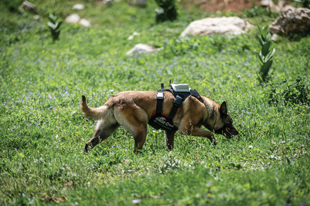
A mine detection dog in the Norwegian People’s Aid clearance site in Bosnia and Herzegovina. Courtesy of Johannes Müller.
T&EP 07.31.02.2022, Competencies required for animal detection system (ADS) handlers, team leaders and instructors
This new T&EP has been developed to provide information on the competencies required to qualify ADS handlers, team leaders, and instructors for their work. This T&EP builds on experience within and outside the mine action sector to define a set of 115 required skills or competencies that personnel must possess to be considered IMAS-compliant ADS handlers and ADS instructors.
This T&EP provides guidance on required competencies for ADS handlers, team leaders, and instructors. It identifies the skills required and recognizes competency gained from operational ADS work.
This T&EP complements EOD and improvised explosive device disposal (IEDD) competency standards. Additional competency standards in demining, mechanical, and non-technical survey are currently being developed.
Revised Technical Note for Mine Action
TNMA 12.10.01, Risk education for improvised explosive devices
This TNMA is concerned with the provision of risk education for improvised explosive devices (IED RE) to the local population in affected countries. It is intended to provide guidance on specific factors to be considered when designing, planning, and conducting IED RE. It is complementary to the general principles and guidance set out in IMAS 12.10 on EORE, which was used as guidance to address the particular factors that may be present in places where IEDs threaten communities.
In addition, the TNMA contains recommendations for the design of messaging and supporting materials for IED RE. Building on the principles established for risk management in IMAS 07.14, the TNMA also provides guidance on the management of specific risks to the intended beneficiaries, EORE teams and operators, and its annexes propose tools to support the management of these risks.
While it is not primarily intended for the provision of safety and security training to the staff of humanitarian organizations, some of the principles set out in this TNMA may be of use to organizations operating in IED-threat environments wishing to provide appropriate advice to their own personnel.
Future Developments in IMAS
The IMAS RB will continue to review and revise IMAS over the course of 2023 and 2024 to ensure they remain fit-for-purpose. The IMAS RB workplan includes revisions to IMAS related to mechanical demining, occupational safety and health, and environmental management in mine action and allows for the development of new doctrine, including T&EPs on deminer, non-technical survey and mechanical competencies, cluster munition remnant survey, and the measurement and reporting of beneficiaries.
The IMAS RB workplan, which contains the list of outputs and timelines, is available on the IMAS website. You can also sign up to receive email alerts when a new or revised IMAS is released by clicking on the ‘sign up now’ link on the website homepage.
Abigail Hartley
Chief of the Policy, Advocacy, Donor Relations, and Outreach
United Nations Mine Action Service (UNMAS)
 Abigail Hartley is the Chief of the Policy, Advocacy, Donor Relations, and Outreach at the United Nations Mine Action Service (UNMAS) and the IMAS Review Board Chair, with over twenty years of experience in the mine action and humanitarian sectors. She joined the UNMAS program as a Senior Programme Officer and thereafter held posts of Chief of Staff and Programme Manager overseeing policy, political, legal, humanitarian, social, and economic aspects of the program. Her responsibilities include the leadership of the Inter-Agency Coordination Group on Mine Action, development of mine action policy, monitoring of the UNMAS Strategy 2019–2023, and advocacy in support of mine-related international legal instruments. She spent almost six years with UNMAS in Afghanistan, and also worked for many years with Mines Advisory Group (MAG) globally but primarily in South Sudan, Sri Lanka, and Sudan. Ms. Hartley is a graduate of the Universities of Newcastle-upon-Tyne and Bradford and holds a Master’s in International Politics and Security Studies.
Abigail Hartley is the Chief of the Policy, Advocacy, Donor Relations, and Outreach at the United Nations Mine Action Service (UNMAS) and the IMAS Review Board Chair, with over twenty years of experience in the mine action and humanitarian sectors. She joined the UNMAS program as a Senior Programme Officer and thereafter held posts of Chief of Staff and Programme Manager overseeing policy, political, legal, humanitarian, social, and economic aspects of the program. Her responsibilities include the leadership of the Inter-Agency Coordination Group on Mine Action, development of mine action policy, monitoring of the UNMAS Strategy 2019–2023, and advocacy in support of mine-related international legal instruments. She spent almost six years with UNMAS in Afghanistan, and also worked for many years with Mines Advisory Group (MAG) globally but primarily in South Sudan, Sri Lanka, and Sudan. Ms. Hartley is a graduate of the Universities of Newcastle-upon-Tyne and Bradford and holds a Master’s in International Politics and Security Studies.
Lionel Pechera
Advisor on Mine Action Standards
Geneva International Centre for Humanitarian Demining (GICHD)
 Lionel Pechera has worked at the Geneva International Centre for Humanitarian Demining (GICHD) as an Advisor on mine action standards since December 2021. In this role, he has coordinated several IMAS technical working groups leading to the creation or revision of IMAS documents. He also supports training on IMAS and the development of national mine action standards. Mr. Pechera previously worked with the United Nations Mine Action Service in Mali and Nigeria as a project manager and program coordinator. Prior to that, he served as a combat engineer officer in the French military for two decades, deploying to Central Asia, East Africa, and South America, and supporting the development of standards for the North Atlantic Treaty Organization. He holds a Master’s in International Affairs, Ecole Spéciale Militaire de Saint-Cyr.
Lionel Pechera has worked at the Geneva International Centre for Humanitarian Demining (GICHD) as an Advisor on mine action standards since December 2021. In this role, he has coordinated several IMAS technical working groups leading to the creation or revision of IMAS documents. He also supports training on IMAS and the development of national mine action standards. Mr. Pechera previously worked with the United Nations Mine Action Service in Mali and Nigeria as a project manager and program coordinator. Prior to that, he served as a combat engineer officer in the French military for two decades, deploying to Central Asia, East Africa, and South America, and supporting the development of standards for the North Atlantic Treaty Organization. He holds a Master’s in International Affairs, Ecole Spéciale Militaire de Saint-Cyr.
Sasha Logie
IMAS Secretary
Geneva International Centre for Humanitarian Demining (GICHD)
 Sasha Logie is currently the IMAS Secretary to the IMAS Review Board and IMAS Steering Group. As the IMAS Secretary, his responsibilities include the coordination and management of the process through which the IMAS framework is maintained and developed, a function which is implemented in close coordination with the United Nations Mine Action Service (UNMAS) and the wider IMAS Steering Group and Review Board. Mr. Logie previously worked with the United Nations Mine Action Service as a Senior Programme Officer in South Sudan, and later as the head of the UNMAS Palestine Programme. He has also worked with the United Nations Office for Project Services and the British Government on issues related to environmental programs. His academic background includes a Master's in International Politics from the University of London.
Sasha Logie is currently the IMAS Secretary to the IMAS Review Board and IMAS Steering Group. As the IMAS Secretary, his responsibilities include the coordination and management of the process through which the IMAS framework is maintained and developed, a function which is implemented in close coordination with the United Nations Mine Action Service (UNMAS) and the wider IMAS Steering Group and Review Board. Mr. Logie previously worked with the United Nations Mine Action Service as a Senior Programme Officer in South Sudan, and later as the head of the UNMAS Palestine Programme. He has also worked with the United Nations Office for Project Services and the British Government on issues related to environmental programs. His academic background includes a Master's in International Politics from the University of London.
| Stay updated | |||
